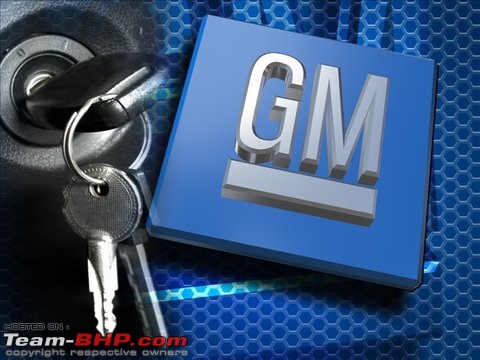Most of us are aware of the ongoing GM's infamous recall for vehicles which were equipped with a faulty ignition switch. It has already been brought out in the other
thread but I believe this one deserves its own thread for the gravity of the situation which would be apparent as you read through. I have compiled all the information from various sources which have been mentioned at the end of the thread.
Estimated number of vehicles affected: 2.6 million.
Cars affected: 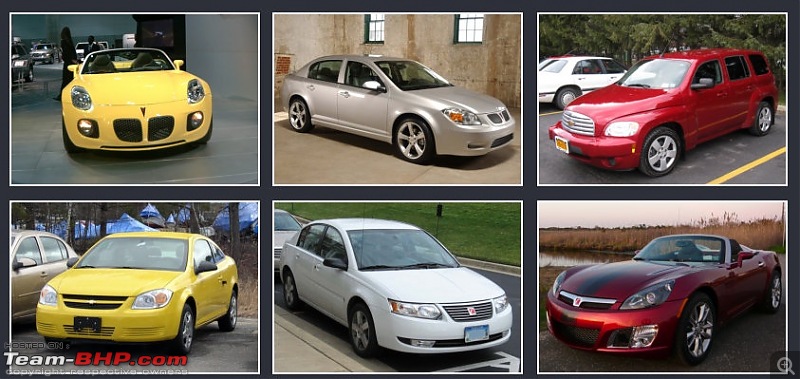 (Clockwise from top-left)
(Clockwise from top-left) 2006-10 Pontiac Solstice, 2007-10 Pontiac G5/2005-06 Pontiac G4/Pursuit (Canada & Mexico only), 2006-11 Chevrolet HHR, 2005-10 Chevrolet Cobalt, 2003-07 Saturn Ion and 2007-10 Saturn Sky.
Parts involved: Ignition switch, ignition lock cylinder and key.
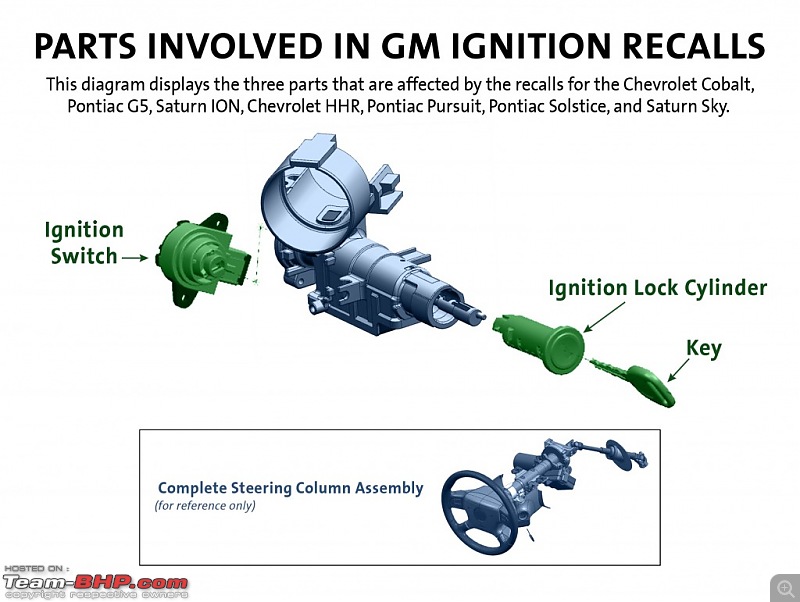 Cause of recall:
Cause of recall: A component inside the ignition switch manufactured by Delphi Automotive - the
switch indent plunger designed to provide sufficient torque for the key to remain in the engine ON position fails to do so and the key would automatically revert back to the ACC (accessory) position shutting off the engine and preventing the airbags from deflating. The key would move back to the ACC position in case of a heavily-weighted key ring or if the car goes over rough roads.
This is the official statement from GM from their
press release:
Quote:
| GM is recalling these vehicles because the ignition switch torque performance may not meet GM specifications. If the torque performance is not to specification, and the key ring is carrying added weight or the vehicle goes off road or experiences some other jarring event, the ignition switch may inadvertently be moved out of the “run” position. |
This image should make it clear:
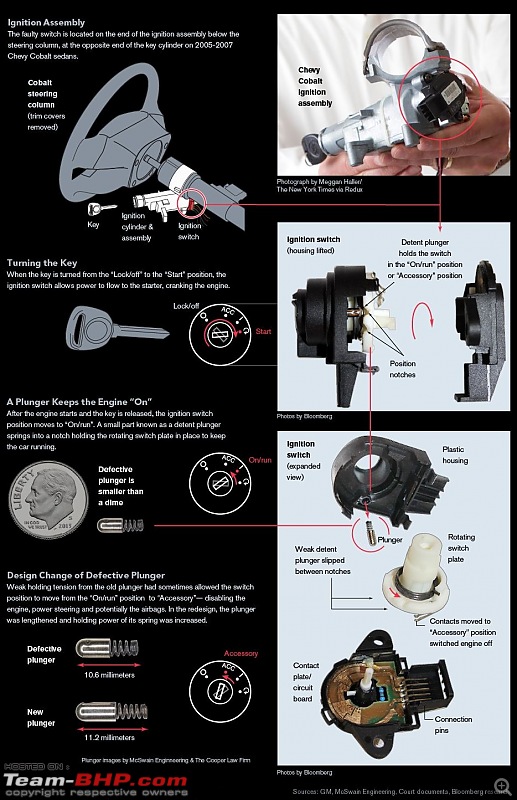 Aftermath:
Aftermath: At least 13 people have been killed in 31 accidents linked to this component since 2004, and the world's second largest automaker is currently slapped with criminal charges. The recall has also cost the shareholders $3 billion over four weeks!
The irony: The fault had been known to GM for
at least a decade prior to the recall being declared! Some have even suggested that the company actually approved the switches in 2002 even though they knew they might not meet safety standards.
GM failed to respond to a special order from NHTSA (dated March 4 2014) and claimed that litigation lawyer Anton R. Valukas and his team was investigating the issue and thus, they couldn't respond. NHTSA has clearly responded that this excuse is "
irrelevant to GM's legal obligation to timely respond to the Special Order and fully cooperate with NHTSA". As a result, GM has been fined with $28,000 and will continue to be fined at a rate of $7,000 per day until it meets the requests in the said letter. If GM doesn't comply, NHTSA could refer the case to the Department of Justice.
This is the best part from the letter "
Moreover, it is deeply troubling that GM is unwilling or unable to tell NHTSA whether the design of the switch changed at any other time."
Read the entire letter here -
217114568-NHTSA-Letter-To-GM-April-8-2014.pdf The timeline of events (courtesy Jalopnik): 2001: An official GM document records an ignition switch cutting power to a car, in this case a pre-production Saturn Ion, the Wall Street Journal reports.
2002: Saturn Ion production starts.
2003: A GM service technician observes a Saturn Ion stalling while driving and figures out that the ignition switch was worn down by a heavy key chain. The service technician replaces the ignition switch and the file is closed.
2004: A GM engineer is driving a Cobalt and experiences the switch cutting off the car's power. This includes the engine, power steering, power brakes, ABS, and airbags. Other engineers replicate the cutoff. In 2014, GM claimed that this 2004 incident was the first instance of this problem being recorded.
2005: Cobalts go on sale, GM gets more complaints about the cars losing power, GM issues a service bulletin on how to fix the problem with a key insert. Only 474 people get the insert.
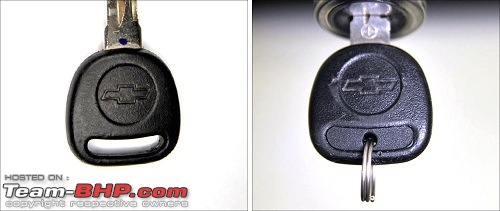 One GM engineer analyzes the cost of fixing the switch altogether. The number rings up to a mere 57 cents.
One GM engineer analyzes the cost of fixing the switch altogether. The number rings up to a mere 57 cents. The engineer's report concludes this fix does not represent "an acceptable business case."
2006: A GM design engineer approves a change to the ignition switch. The changes are small, including a new detent plunger and a tougher spring. The new ignition switch does not get a new part number. The head of the Cobalt program also starts a program that puts pressure on engineers to reduce the number of parts changes within the design process. That executive's husband brags about slashing GM's engineering budget to the tune of a $1 billion savings.
2007: NHTSA alerts GM of the first ignition switch-related fatality.
2008: Zilch, according to
this NHTSA document.
2009: The birth of 'New GM,' GM starts officially looking into weighty key chains turning off cars. GM then meets with the supplier that makes the switch and discusses the problem as it directly relates to fatal crashes.
2010: GM stops making the Cobalt. Brooke Melton dies at the wheel of her 2005 Cobalt. The switch shuts off the car's power and in the crash, the airbag does not deploy. This will become the case that brings the ignition switch mess to light.
2011: GM's legal department meets with their recall teams to look into airbags not deploying in Cobalts and Pontiac G5s during crashes. GM assesses that the switching-off ignitions could be the cause.
2012: A GM engineer assigned to the case of the no-airbag crashes figures out that a number of ignition switches on Cobalts, G5s, and other cars dating back to 2003 turn off too easily. That is, that the switches were built below GM's standards.
2013: After extensive testing, GM's team assigned to the no-airbag-deployment cars problem figures out that there's a significant number of Cobalts from before 2007 have substandard ignition switches. This GM team then discovers, possibly for the first time, that a different engineering team approved a change to the ignition switch back in 2006 without changing the parts number. GM settles the Brooke Melton case.
2014: Mary Barra becomes GM's CEO (
related thread), only two weeks before she claims she first hears about the ignition switch problem. News of the Melton case comes to light. GM starts recalling millions of cars that could have faulty switches, fully a decade after the problem is first recognized.
US Senator Barbara Boxer questioned Mary Barra on rental car safety at a hearing and eventually slams her. Watch the video below:
Barra's testimony also stated that she doesn't know why it took nearly a decade to try to initiate a recall, but that she has accelerated efforts to fix the switches and that she offers "
my sincere apologies to everyone who has been affected by this recall, especially to the families and friends of those who lost their lives or were injured. I am deeply sorry."
Departure of Executives and Engineers: On April 10 2014, GM had announced that two engineers Gary Altman and Ray DeGiorgio, have been placed on paid leave (that means a vacation in the middle of an investigation?!) and that it was a "difficult decision." And one of them appears to be the Cobalt and Cruze's engineering manager! Bloomberg says, DeGiorgio had approved a design change in 2006 that improved the spring in the faulty ignition switch and made it more robust, authorizing its production without fully documenting the decision, according to a letter sent to Barra last week by Democrats on the House Energy and Commerce Committee.
On April 14, 2014, GM announced that two of its executives - Selim Bingol, SVP for global communications and public policy, and Melissa Howell, SVP for global HR were departing the company. GM did not comment on whether they had resigned or were fired. (
Press Release)
Lawsuits Filed: After the recall was announced by GM, a large number of lawsuits were filed by those claiming to have been injured due to the recalled vehicles' faulty switches, including two class action ones. Two other lawsuits have also named Delphi Automotive, the car parts manufacturer who produced the defective switches, as one of the parties partly responsible for the deaths caused by the now-recalled vehicles.
What this means for GM: This recall is going to cost GM dearly;
old GM or the
new GM post-bankruptcy doesn't matter here. Recall that Toyota had to pay $1.3 billion for a class action settlement during March 2014, wherein Toyota was charged with intentionally hiding information about safety defects from the public (concerning unintended acceleration) and deceiving the customers to protect its brand image. That was the largest sum of money penalised against a car company for a settlement! Of course, for the world's largest carmaker this is literally peanuts. GM's incompetency and the cover-up for over a decade has resulted in the loss of 13 lives and several injuries (some of them have went unreported). Their only way out is to come clean, admit the wrongdoings, fix the faulty part in all the cars that were sold and pay a (handful) sum to close the settlement. In the history of recalls, this one would be a significant one by all counts.
Workaround from GM: Jeff Boyer, Vice President, Global Vehicle Safety suggests using a single key instead of a heavy bunch of keys on the key chain and after the vehicle has been repaired by the dealer, use the GM issued keys with a hole instead of replacement keys that come with a slot.
Alas, this solution has come delayed by just over a decade! Whatever it is, good luck GM! You are going to need it.
 Sources:
Sources: Jalopnik, IB Times, Bloomberg, WSJ, The Family Deal Blog, Car and Driver. Images copyright respective owners.

 (7)
Thanks
(7)
Thanks

 (2)
Thanks
(2)
Thanks
 (6)
Thanks
(6)
Thanks

 (1)
Thanks
(1)
Thanks
 (1)
Thanks
(1)
Thanks




